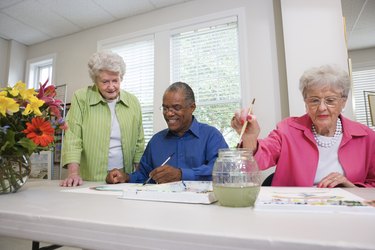
Leading an arts and crafts class for seniors is largely a matter of proper planning and organization. An arts and crafts group is an ideal way for seniors to develop friendships and remain active. Seniors who have opportunities to socialize with others experience a good quality of life, because an active lifestyle helps keep depression and loneliness at bay. Hobbies such as arts and crafts are also effective ways to reduce stress and maintain a healthy brain.
Place
Video of the Day
Select a site for the senior arts and crafts group. Ensure that the site has no steps or other barriers for group members who use walkers or wheelchairs. The site should be well lit with adequate heat or air conditioning.
Video of the Day
Numbers
Decide how many seniors to include in your group. This decision depends on factors such as available space and the capabilities and interests of the seniors. Usually, five or 10 people are a good number for an arts and crafts group. Arrange for an assistant to help with arts and craft projects if necessary.
Projects
Determine a project, or projects, for the senior arts and crafts group. Many seniors enjoy a knitting, crocheting or quilting class, while others may prefer ceramics, scrapbooking, jewelry-making, painting or drawing. Don't assume that seniors are incapable of challenging crafts or that they require childlike projects. However, some older seniors may prefer simple, colorful crafts such as beaded bracelets, leaf collage or simple handmade cards. Some projects, such as working with clay or making a mosaic trivet, are appropriate for a range of skills and mobility.
Equipment
Consider possible physical restrictions. For example, seniors with arthritis may need lightweight tools with large handles. Those with poor eyesight will appreciate large print and projects that don't require difficult tasks such as threading a needle.
Materials
Make a list of all necessary materials for the crafts, and then provide group members with a copy of the list before the class begins. If you are providing the materials, have them ready ahead of time so that you don't have to purchase them at the last minute.
Time Limit
Set a time limit for the craft group. Usually two or three hours is plenty of time for socializing and craft work, but an hour may be enough for seniors who tire easily.
Leading the Class
Prepare a sample of the project before the class begins, and then display the finished project to the seniors. Demonstrate the techniques involved, allowing time for questions and discussion. Guide seniors through the project step by step, offering individualized help when necessary.
Refreshments
Provide refreshments for the senior craft group, as refreshments not only promote socializing, but help to maintain energy. Select simple refreshments such as cookies or brownies with juice and coffee. Alternatively, the group members may enjoy providing the refreshments.